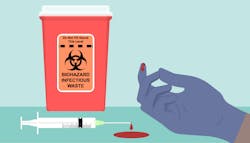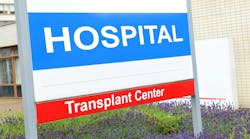When a public health emergency strikes, such as COVID-19, it illuminates the many risks and hazards in healthcare devices, environments and practices. It also shines a light on the fortitude of hospital and other healthcare staff continuing to persevere in caring for communities through the many ups and downs of this pandemic.
Like no other major health crisis in history, COVID-19 revealed numerous vulnerabilities and challenges accessing necessary supplies, devices, equipment and personal protective equipment (PPE) for care and infection protection in hospitals and medical facilities. COVID-19 also sharpened the focus on following established and adapted standards and guidelines in safety to help reduce the spread of pathogens and infections and prevent injuries and other harm among staff and patients.
Sharps devices, consequently, grew as much needed supplies in COVID-19 care and vaccine administration, points out Judy LaJoie, DNP, RN, CRNI, Chief Nurse, Director of Medical Affairs for Medication Delivery Solutions, BD.
Collaboration with the U.S. and other governments months prior to vaccine approvals allowed BD to adapt manufacturing output to support vaccine rollout while continuing to supply the commercial market for routine healthcare, flu vaccination and childhood immunizations programs,” she noted.
Injuries versus infections
How have sharps injuries affected staff, patients, procedures and treatment pre- and current COVID pandemic?
“The largest percentage of sharps injury in 2018 occurred in the operating room [44.3% EPINet, 35.1% Massachusetts Sharps Injury Surveillance System (MSISS)],” Calabrese explained. “Additionally, within the OR, surgeons experienced the greatest number of injuries (52.8% EPINet, 58‑.05 MSISS). These statistics reveal the OR may be the area to scrutinize and provide our greatest impetus for change. Often stated, not necessarily embraced, education and action can remodel our future.”
Additional challenges and risks in care have emerged during the current crisis, observes Calabrese.
“Standard precautions are used for all patient care in the OR, ER or anywhere there is risk of transmission from blood and body fluids,” she indicated. “COVID-19 patients, sickness and deaths made the pandemic a reality. HCWs in this generation have never experienced this trepidation and dread. Fear and reality will awaken and elevate safety precautions to a higher level. The impact of COVID-19 was a heightened awareness of sharps safety because a mistake resulting in a sharp injury can change your life.”
Continuing to watch out for healthcare staff safety and infection control into the future, The International Safety Center “last year released a consensus statement, Moving the Sharps Safety in Healthcare Agenda Forward in the United States: 2020 Consensus Statement and Call to Action,”1 reported the American College of Surgeons.
The college continued, “The risks of occupational exposure to blood, body fluids, and other potentially infectious materials (OPIM) are greater today than in decades past. Increased global travel can result in broad spread of emerging infectious diseases. The emergence of these previously unknown pathogens, such as COVID-19, highlights the critical role that the safety and health of healthcare workers play and the importance of protecting them from workplace hazards. Additionally, the increased prevalence of individuals living with co-infections such as HIV and HCV, and the growing pressure for providers to see more patients in less time, exacerbates the risk of work-related exposures to disease. It is our goal to continue to focus on ways to protect healthcare personnel from harm, thus mitigating these risks.”
A federal action taken on behalf of healthcare worker safety is the “Needlestick Safety and Prevention Act (NSPA) signed on Nov. 2, 2000,” reports LaJoie of BD.
“Following NSPA, U.S. healthcare facilities have adopted the use of safety-engineered devices to reduce the risk of accidental needlestick injuries and the transmission of bloodborne pathogens to healthcare practitioners,” she explained. “BD supported this effort prior to NSPA being signed into law and continues to advocate on behalf of healthcare practitioners for the use of safety-engineered devices and proper disposal of sharps. As COVID-19 vaccination efforts took many healthcare practitioners outside of hospital or retail pharmacy settings, BD has generated new education materials on the proper use and disposal of its devices.”
Calabrese envisions growing opportunities for improvements in these incidences in care settings.
“In my opinion, awareness and dedication to sharps safety is lacking throughout institutions,” she expressed. “Now, in 2021 we require a new impetus on safety. Leadership has to fill in the gaps, engage clinicians, manufacturers, and professional and accrediting associations to not only advocate for safety but to inspire HCWs to foster a culture of safety throughout healthcare facilities. There are a litany of best practices, products and technology available, however, HCWs must be compelled to actually use them.”
Ramping up disposal
How have clinical, infection prevention or safety leaders handled sharps safety in their facilities?
A drive toward getting more shots in arms in communities means an increased need for disposal of sharps supplies.
“A shortage in the supply of Food and Drug Administration (FDA)-cleared sharps disposal containers may occur during the COVID-19 mass vaccination campaign or as a result of other causes. Healthcare facilities and COVID-19 vaccination sites must use sharps disposal containers that meet Occupational Safety and Health Administration (OSHA) Bloodborne Pathogens standard requirements to dispose of contaminated needles and other sharps,”2 stated the Centers for Disease Control and Prevention in its guidance.
The agency added, “Conserve your FDA-cleared sharps disposal containers to help avoid a potential supply shortage. If FDA-cleared sharps disposal containers are unavailable, then consider using alternative containers that meet the OSHA requirements after checking your state’s specific disposal requirements at SafeNeedleDisposal.org and discussing disposal options with your medical waste vendors.” 2
The FDA explained it “has evaluated the safety and effectiveness of these containers and has cleared them for use by health care professionals and the public to help reduce the risk of injury and infections from sharps. FDA-cleared sharps disposal containers are made from rigid plastic and come marked with a line that indicates when the container should be considered full, which means it’s time to dispose of the container.”3
With regard to alternative sharps disposal containers, the FDA stated, “If an FDA-cleared container is not available, some organizations and community guidelines recommend using a heavy-duty plastic household container. The container should be leak-resistant, remain upright during use and have a tight fitting, puncture-resistant lid, such as a plastic laundry detergent container.”3
Raising bar on safety
What are the best practices for preventing sharps injuries, pathogen contamination and transmission and infections in care?
LaJoie states that “BD recommends the following to help ensure the safety of healthcare practitioners following delivery of a skin injection:
• Activate the safety mechanism immediately following the administration injection
• Keep handling to a minimum
• Discard sharps at point of use into an approved sharps container
• Ensure approved sharps containers are located in a safe position
• Seal sharps containers as soon as the contents reach the indicated fill line and dispose of them according to local policy
• Report needle stick injuries
• Adhere to local policy and procedure, as well as health and safety requirements
• Follow correct use and application of safe medical devices.”
Calabrese highlights clinical practices to help decrease the potential for incidences of surgical site infections (SSIs).
“Going back to COVID, our world revolves around bacteria and viruses,” she stressed. “To combat bacteria, we administer antimicrobial prophylaxis prior to the surgical incision. The risk from a virus, for example, Hep B or C, can be transferred from a needlestick or suture needle penetrating a glove(s).”
She continued, “OR staff can reduce the risk of exposure by 87% when double gloving is used. In another study, the volume of blood on a solid suture needle is reduced by 95% when the needle passes through two gloves/glove layers, reducing the viral load in the event of a pathogenic contamination. National AORN, AST and ACS all agree, the best practice to protect you and your patient is to double glove with a complementary underglove.”
Additionally, Calabrese shares, “Occupational health and safety professionals utilize a system of prevention measures known as the Hierarchy of Controls. This hierarchy is a new element to address the importance of complete safety, first and foremost to eliminate the hazard whenever possible…if this is not feasible, implement work practice engineers.
The umbrella of controls includes:
• Correctly wear PPE.
• Choose the right gauge and length of a needle and evaluate suture needles and alternative methods of skin closure devices where appropriate.
• Increase the use of scalpels with retracting blades/handles and implement no hands passing and neutral zones to protect the surgical team members.
• Utilize correct blood and specimen techniques and increase compliance with disposal of these devices.
If HCWs eliminate the risk of pathogen contamination to the best of their ability, this will transcend to their patients.”
Further, she notes, “The Joint Commission and OSHA advocate for an Exposure Control Plan beginning with the use of universal/standard precautions. OSHA also champions this plan as a living document.”
As COVID-19 vaccinations are on the rise, those administering the shots also should take precautions for sharps safety and infection control.
“Needlesticks and the potential exposure to bloodborne pathogens pose a risk during COVID–19 vaccinations in both traditional healthcare settings and pop-up vaccination sites. Vaccinators should follow OSHA’s bloodborne pathogens standard [OSHA 1992] to prevent needlestick/sharps injuries,”4 advise medical specialists on the National Institute for Occupational Safety and Health Blog.
The specialists continue, “At a minimum, ensure that all vaccinators receive training in the following:
• Bloodborne Pathogens Standard (29 CFR 190.1030)
• PPE
• Sharps disposal
• Definition of needlestick injury
• Injury reporting
• Sharps injury log.”
BD’s LaJoie highlights “two driving factors ensuring safe administration of COVID-19 vaccinations with patients – clinical expertise and the use of safety-engineered devices.
As part of our vaccination response efforts, BD provided resources to help ensure healthcare communities globally have the right training tools and support on injection techniques to implement their campaigns,” she continued. “ This training and education is critical to help ensure that the various devices provided are used properly in vaccine administration, especially as we saw many former and retired healthcare workers returning to the field to help. Additionally, using safety needles designed specifically to protect clinicians from needlestick injuries helps to ensure safe injection practices.”
Looking ahead, collaborative input on sharps devices, injury reviews, training and education will be needed to maintain safety in the growing medical care field and workforce.
“According to the Bureau of Labor Statistics (BLS), the healthcare sector is expected to add 2.4 million new jobs between 2019-2029 (Bureau of Labor Statistics, 2020a). Clearly, this population of workers will continue to be at risk,”1 according to the International Safety Center.
The center added that for healthcare facilities, “It is recommended that:
1. Leadership, management, and frontline staff work cooperatively to select devices with sharps injury prevention (SIP) features and develop sharps safety standards and practices that are consistently implemented and followed in all clinical environments.
2. There is annual documentation for any opt-out policies that detail the rationale for not using a safety engineered device (i.e., compromises patient or worker safety, or clinical outcomes) or intervention, as well as any alternate procedures or practices to mitigate sharps injury risk.
3. There is an annual review of the Sharps Injury Log (without personal identifiers) that is shared with all relevant personnel and a review of current devices and procedures is completed, including a review of new commercially available, safer devices.
4. There is consistent involvement of frontline healthcare workers in the selection and evaluation of devices with SIP, and regular and systematic assessment of devices currently in use.
5. Feedback from frontline staff is provided to manufacturers, kit packers, and distributors to provide prepackaged surgical and procedure kits that include devices with SIP features.
6. Training and education are provided on an annual basis for all potentially exposed workers on the appropriate use and disposal of devices.”1
BD’s LaJoie predicts ongoing improvement in device safety and care.
“The adoption of safety-engineered devices, including needles, has been consistently increasing for years,” she said. “As awareness of the negative consequences of needlestick injuries increases, the trend for adoption in alternate site segments will accelerate and allow for patient and clinician safety to be enhanced.”
Calabrese additionally foresees expanded practice of needleless treatment and safety in care.
“Needle-free drug delivery devices are state of the art and market growth continues to increase during 2020 and 2024,” she indicated. “Market trends for research, funding and government initiatives are on the rise. (Technavio research) Robotics assist the surgeon and the surgical team in various ORs around the country. With specialized devices comes additional risks associated with technology; it would seem HCWs will always require protection from something!”
References:
1. International Safety Center Releases Consensus Statement on Sharps Safety, https://www.facs.org/about-acs/consensus-statements/sharps-safety
2. Strategies for Sharps Disposal Container Use During Supply Shortages For Managers and Purchase Agents, https://www.cdc.gov/vaccines/covid-19/downloads/strategies-sharps-disposal-container.pdf
3. Sharps Disposal Containers, https://www.fda.gov/medical-devices/safely-using-sharps-needles-and-syringes-home-work-and-travel/sharps-disposal-containers
4. Preventing Needlestick Injuries at COVID–19 Vaccination Sites, https://blogs.cdc.gov/niosh-science-blog/2021/03/02/needlestick-prevention/







